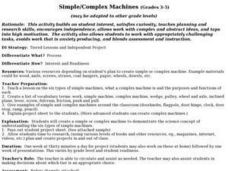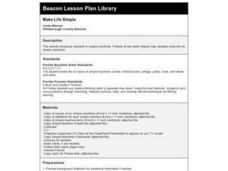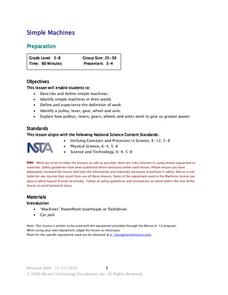Curated OER
Simple Machine Research
Fifth graders demonstrate the ability to use scientific skills and Processes to describe forces that act upon objects to cause specific changes in motion. They identify and describe a science problem related to forces and simple machines.
Curated OER
Levers and Pulleys
Seventeen pages of material leave you well-prepared to carry out this lesson on levers and pulleys. Photos and diagrams make the instructions clear; resource links provide additional information. The missing aspects of this teacher's...
Agriculture in the Classroom
Six Kinds Do It All
Teach young engineers that all machines, no matter how complicated or complex, are made up of just six simple devices with this hands-on physical science lesson. Using the included templates, students first create paper models of...
Curated OER
Simple/Complex Machines
Students make a simple machine. For this physics lesson, students learn about six types of simple machines and the purpose of each and brainstorm examples of simple and complex machines in the classroom. Students create a simple or...
Curated OER
Make Life Simple
Students examine six simple machines by looking at pictures of real world objects.
Curated OER
Qualitative Examples of Conservation of Mechanical Energy
Instructions for series of six activites, a reading of scientific literature, and a choice of six assessments await you in this physics resource. Well-written plans guide you in guiding your pupils to experiment with levers, pulleys,...
Curated OER
Simple Machines
Students research simple machines. In this simple machines lesson, students explore the many types of simple machines such as the lever, pulley, and screw. Students discover simple machines in the classroom.
Curated OER
Simple Machines
Students engage in a lesson that explores the concept of simple machines. They view a powerpoint media presentation and then are introduced to adult volunteers for the lesson. Each volunteer is at a station with a simple machine and...
Curated OER
An Invitation to Simple Machines
Third graders explore simple machines as a way of helping the principle with a hurt foot manuever his way around the campus.
Curated OER
Simple Machines in the Home
Students explore simple machines used in the home. In this simple machines lesson, students discover that many household items are constructed from simple machines. Students interact with nutcrackers, peelers, egg slicers, and egg beaters.
Curated OER
Challenger's Lost Lessons - The Lost Simple Machines Lesson
Students investigate the characteristics of simple machines. In this simple machine lesson, students investigate work as a product of applying constant force. They answer questions about what happens on Earth and what may have happened...
Curated OER
Simple Machines
Third graders examine and identify the six types of simple machines. Using a model of each simple machine, they demonstrate the state the function of them to the class. They discover examples of simple machines at school and home and...
Curated OER
On a Hunt for Simple Machines
Fifth graders identify six simple machines. They brainstorm types of machines and complete a KWL chart. Students observe and explain six simple machines found in the classroom and in their home. They share their list with the class.
Curated OER
A Simple Machines Activity
Fourth graders observe examples of simple machines found in the school, playground, and work environment. In this simple machines lesson, 4th graders review simple machines by viewing three web sites. Students tour the school and grounds...
Curated OER
An Introduction to Simple Machines
Students investigate simple machines and their uses in everyday life. In this scientific method lesson, students examine physical tools such as wedges, screws, and levers using a "how does it work" approach. Students complete...
Curated OER
Exploring Simple Machines
Students investigate simple machines. In this simple machines instructional activity, students study how simple machines work. Students determine the function of various simple machines.
Alabama Learning Exchange
Simple Machines Internet Research
Students identify six types of simple machines, then use the Internet for research.
Curated OER
Simple Machines
Students are introduced to a scenario: a ramshackle house is in need of repair. The roof leaks, the refrigerator is broken, it needs paint, etc. They are explained that in order to repair the home, students must use tools. Students...
Curated OER
Simple Machines and Modern Day Engineering Analogies
Students apply the mechanical advantages and problem-solving capabilities of six types of simple machines (wedge, wheel and axle, lever, inclined plane, screw, pulley) as they discuss modern structures in the spirit of the engineers and...
Curated OER
Powerful Pulleys
Students explore the building of a pyramid and how pulleys were used to change the direction of applied force. They demonstrate the mechanical advantage of using a pulley and apply it to modern engineering.
Curated OER
A Simple Block and Tackle Pulley Demonstration
Students investigate the scientific concept of mechanical advantage. They construct their own system with the use of a simple broomstick. Then the demonstration is done to show how the mechanical advantage is used to move a load.
Curated OER
Is a Pulley a Special Kind of Lever?
Fifth graders use information from their text to read and discuss pulleys and levers. They examine a top sketch of the arrangement of a fixed pulley. Working in groups, 5th graders perform experiments to test the effect of using a pulley...
Curated OER
TE Activity: Pulley'ing Your Own Weight
Students experiment with common objects such as spools, string and soap to determine how pulleys make it easier to move large objects. They look at the difference between fixed and movable pulleys. They examine the many uses engineers...
Curated OER
Machines: Not So Simple
Students examine the names and images of simple machines in a matching activity. They build a simple machine using K'NEX before taking and printing out a digital picture of their example. They complete five station activities based on...

























